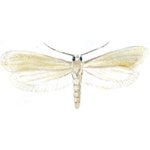
Clothes moths belong to man’s oldest companions. In the Bible, they are used as an image of transitoriness, and our short lives are described as: “-clothes that are eaten up by moths”.
The small bronze-shining clothes moth (Tineola bisselliella) prefer hidden lives in dark corners, drawers and cupboards. They are poor fliers, and it is actually rare to have the opportunity to slap a clothes moth in free flight.
The female moth lays about 100 small, whitish eggs, which she tucks into folds or between threads in the fabric. The eggs hatch in a few days and the larvae immediately start to eat. At the same time they spin a fine, silken tube, that is adhesively put on the substrate. They can move in the pipe, and it can be extended when the larva has eaten all that it can reach from it Gnawed remnants and larval excrement sticking to the tube, and the presence of these webs is clear proof that it is the moths, and not other textile pests that have been gnawing.
The development from egg to adult moth lasts from one month to over a year depending on temperature, humidity and food quality. Under normal circumstances in our homes, there will be two generations per year.
Clothes moths thrive best at a temperature of 25 degrees C. This shows us that they originate from a warmer climate, and in Northern climates you will not find them outdoors.
Larval diet consists predominantly of horn substance (keratin) as they can find in wool, fur and feathers. It is one of the most non-digestible proteins, but these moths have special conditions in their guts so that they can digest these proteins. However, there are missing some necessary vitamins in it completely clean horn substance, so the larvae must have something else to eat in order to thrive, perhaps in the form of dirt of one kind or another in the clothes.
Clothes moths do not attack cotton nor synthetic fabrics, and as many fabrics today are treated against moths, the moths are not as common today as they were earlier, but there is still food enough for them in most households.
The female moths do not take food for themselves, and they are not like their larvae equipped with jaws to chew. This means that clean clothes in tightly closed bags of paper or plastic are effectively protected against moth infestations.
The extermination can in most cases be done by placing the infested goods in a freezer for a few days. Washing them in the washing machine will also effectively kill the eggs, larvae and adult moths. There are approved pesticides to exterminate clothes moth, and they are particularly suitable for treating cracks and fissures in closets, drawers and under the baseboards, which can hide larvae.
The case bearing clothes moth (Tinea pellionella) resembles the common clothes moth, their larvae, however, is easy to recognise. They spin a small tubular sheath, a casket which they occupy with wool and feather debris. They can, in contrast to the clothes moth larvae, crawl around with the rear body protected in the sheath. They have a tendency to move away from the place they have spent larval life when they are fully grown. If they have lived in a carpet, you can often see them crawling up the wall in search of a protected place for pupation, which happens inside the sheath.
The case bearing clothes moth has lower demands for temperature, and is a native, Northern European species which you, among other places, can find in birds’ nests. They are able to enter your home from the outside. They, however, require quite humid conditions, and do not thrive in dry rooms.
Otherwise their lives are a lot like that of the common clothes moth, and measures for prevention and control are the same.




